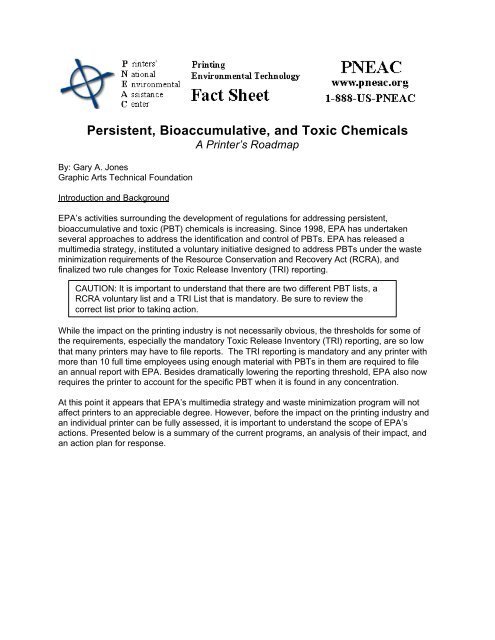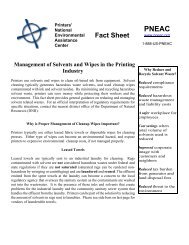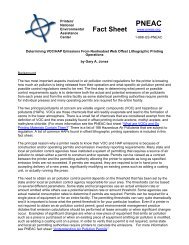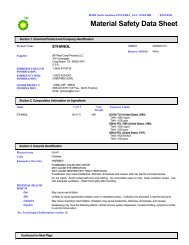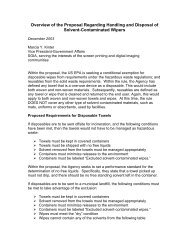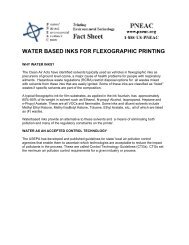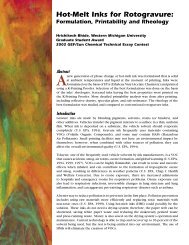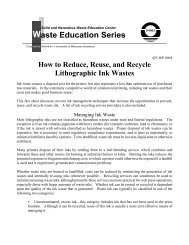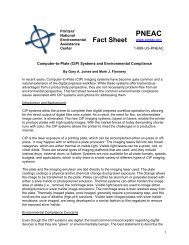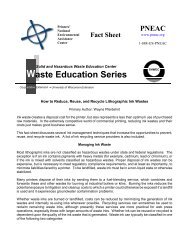Persistent Bioaccumulative and Toxic Chemicals: A Printers Roadmap
Persistent Bioaccumulative and Toxic Chemicals: A Printers Roadmap
Persistent Bioaccumulative and Toxic Chemicals: A Printers Roadmap
Create successful ePaper yourself
Turn your PDF publications into a flip-book with our unique Google optimized e-Paper software.
<strong>Persistent</strong>, <strong>Bioaccumulative</strong>, <strong>and</strong> <strong>Toxic</strong> <strong>Chemicals</strong>A Printer’s <strong>Roadmap</strong>By: Gary A. JonesGraphic Arts Technical FoundationIntroduction <strong>and</strong> BackgroundEPA’s activities surrounding the development of regulations for addressing persistent,bioaccumulative <strong>and</strong> toxic (PBT) chemicals is increasing. Since 1998, EPA has undertakenseveral approaches to address the identification <strong>and</strong> control of PBTs. EPA has released amultimedia strategy, instituted a voluntary initiative designed to address PBTs under the wasteminimization requirements of the Resource Conservation <strong>and</strong> Recovery Act (RCRA), <strong>and</strong>finalized two rule changes for <strong>Toxic</strong> Release Inventory (TRI) reporting.CAUTION: It is important to underst<strong>and</strong> that there are two different PBT lists, aRCRA voluntary list <strong>and</strong> a TRI List that is m<strong>and</strong>atory. Be sure to review thecorrect list prior to taking action.While the impact on the printing industry is not necessarily obvious, the thresholds for some ofthe requirements, especially the m<strong>and</strong>atory <strong>Toxic</strong> Release Inventory (TRI) reporting, are so lowthat many printers may have to file reports. The TRI reporting is m<strong>and</strong>atory <strong>and</strong> any printer withmore than 10 full time employees using enough material with PBTs in them are required to filean annual report with EPA. Besides dramatically lowering the reporting threshold, EPA also nowrequires the printer to account for the specific PBT when it is found in any concentration.At this point it appears that EPA’s multimedia strategy <strong>and</strong> waste minimization program will notaffect printers to an appreciable degree. However, before the impact on the printing industry <strong>and</strong>an individual printer can be fully assessed, it is important to underst<strong>and</strong> the scope of EPA’sactions. Presented below is a summary of the current programs, an analysis of their impact, <strong>and</strong>an action plan for response.
Multimedia PBT StrategyOn November 17, 1998, EPA released in the Federal Register its multimedia PBT strategy.EPA’s multimedia strategy is designed to implement the agreements made under the Canada-U.S. Binational <strong>Toxic</strong>s Strategy. A full copy of the strategy can be found at www.epa.gov/pbt.The strategy includes approaches to:1. Develop <strong>and</strong> implement national action plans for 12 priority PBT pollutants. The plans willcombine regulatory, enforcement, <strong>and</strong> voluntary elements. The first to be addressed arethose identified as Level 1 substances identified below.2. Screen <strong>and</strong> select more priority PBT pollutants for action.3. Prevent the introduction of new PBT pollutants into commerce.4. Measure progress by linking activities to environmental results.Level 1 Priority PBTsChemicalCAS NumberAldrin/dieldfin 309-00-2Benzo(a)pyrene 50-32-8Chlordane 57-74-9DDT (dichlorodiphenyltrichloroethane)Octachlorostyrene 29082-74-4Hexachlorobenzene 118-74-1Alkyl-leadMercury <strong>and</strong> CompoundsVariousPolychlorinated biphenyls (PCBs)VariousDioxins <strong>and</strong> FuransVariousToxaphene 8001-35-2Bold – Indicates substances that could possibly be found in printing operations.The strategy includes an action plan for reducing mercury pollution. Under the Canada-U.S.Binational <strong>Toxic</strong>s Strategy, EPA has agreed to reduce by 50% the deliberate use of mercury<strong>and</strong> a 50% reduction in releases from sources resulting from human activity. The plan focuseson controlling emissions from point sources, revising water quality criteria, seeking reductions inmercury use, developing environmentally acceptable disposal techniques, reducing exposure tohighly exposed populations, enhancing enforcement on illegal use <strong>and</strong> disposal, continueinginternational efforts on reducing its use, <strong>and</strong> conducting further research.2
PBT Waste Minimization ProgramIn the November 9, 1988 Federal Register, EPA released a preliminary list of 53 PBTsfrequently found in hazardous waste. EPA’s proposal for the PBTs found in hazardous wastewere intended to encourage facilities that generate wastes containing the listed PBTs to eitherchange their manufacturing process or their materials to reduce the amount of waste containingthe PBTs. This would reduce the need to incinerate or otherwise treat these PBT containingwastes. EPA’s goal was to reduce the amount of the 53 PBT chemicals found in the wastestreams by 10% in 2000 <strong>and</strong> by 50% in 2005. A web site, www.epa.gov/wastemin, containssupporting information, fact sheets, <strong>and</strong> the list of chemicals. The following chart presents theinitial 53 chemicals identified under this program.3
Initial PBT <strong>Chemicals</strong> Subject To Voluntary RCRA Waste Minimization PlanChemical CAS # Chemical CAS #Dioxins <strong>and</strong> FuransOrganonitrogensDioxins Various Nitrobenzene 98-95-3Furans Various Cyanide 57-12-5Chlorinated SolventsNonhalogenated PhenolicsChloroform 67-66-3 Phenol 108-95-21,1-Dichloroethene 75-34-3 2,4,6,-Tris-(1,1-Dimethylethel)phenol 732-26-31,1,1-Trichloroethane 71-55-6Phthalate EstersChlorobenzenes Bis-(2-ethylhexyl) phthalate 117-81-71,2-Dichlorobenzene 95-50-1 Butylbenzyl phthalate 85-68-71,3-Dichlorobenzene 541-73-1 Dibutyl phthalate 84-74-21,4-Dichlorobenzene 106-46-71,2,4-Trichlorobenzene 120-82-1 Polycyclic Aromatic Hydrocarbons1,2,4,5-Tetrachlorobenzene 95-94-3 Acenaphthene 83-32-9Pentachlorobenzene 608-93-5 Acenaphthylene 208-96-8Hexachlorobenzene 118-74-1 Benzo(g,h,i)perylene 191-24-2Fluoranthene 206-44-0Other Halogenated Organics 2-Methylnaphthalene 91-57-64-Bromophenyl phenyl ether 101-55-3 Naphthalene 91-20-3Hexachlorobutadiene 87-68-3 PAH group (as defined in TRI)Octachlorostyrene 29082-74-4 Phenathrene 85-01-8Pyrene 129-00-0PesticidesAlpha-Endosulfan 959-98-8 MetalsBeta-Endosulfan 33213-74-4 Antimony 7440-36-0Heptachlor 76-44-8 Arsenic 7440-38-2Heptachlor epoxides 1024-57-3 Beryllium 7440-41-7Gamma-Hexachlorocyclohexane 58-89-9 Cadmium 7440-43-9Methoxychlor 72-43-5 Chromium 7440-47-3Pentachloronitrobenzene 82-68-8 Copper 7440-50-8Pentachlorophenol 87-86-5 Lead 7440-50-82,4,5-Trichlorophenol 95-95-4 Mercury 7439-97-6Nickel 7440-02-0Selenium 7782-49-2Zinc 7440-66-6Bold – Indicates substances that could possibly be found in printing operations.The preliminary list of 53 PBTs does not contain many of the above 12 priority PBTs, since mostof the original 12 are canceled or banned pesticides. The 53 hazardous waste PBTs are thosechemicals that are currently used in production. It is important to note that the 53 chemicals arenot final <strong>and</strong> EPA has taken comments on the initial list <strong>and</strong> a final list has not been released.4
The selection process used by EPA to identify the 53 chemicals has received a significantamount of criticism. EPA relied on its new Waste Minimization Prioritization Tool, a softwareprogram that scores thous<strong>and</strong>s of chemicals based on their mass generated, persistence,bioaccumulation <strong>and</strong> toxicity. EPA then identified the chemicals that exhibit persistence,bioaccumulation, toxicity, presence in soils <strong>and</strong> sediments of greatest concern on a nationalbasis to the RCRA program, <strong>and</strong> are hard to manage, clean up or pose other RCRA issues. Inresponse to comments received, EPA has revised some of the aspects of the WasteMinimization Prioritization Tool, but additional changes are still underway.EPA plans on tracking the reduction in PBTs by using TRI reports under EPCRA <strong>and</strong> thebiennial reports required to be submitted by Large Quantity Generators. At this time, all but 16of the initial 53 PBTs are on the TRI list.PBT TRI ReportingOn October 29, 1999, EPA lowered the <strong>Toxic</strong> Release Inventory (TRI) reporting threshold for 19PBTs subject to reporting under EPCRA <strong>and</strong> on January 17, 2001, for lead <strong>and</strong> leadcompounds. The complete list of substances required to be reported under the <strong>Toxic</strong> ReleaseInventory reporting can be found TRI PBT Reportable <strong>Chemicals</strong> table below.Under the PBT rule changes, any facility that manufacturers, processes, or uses certain PBTs inquantities greater than 10 pounds (4.5 kilograms) per year or others greater than 100 pounds(45 kilograms) per year must be reported. The 10-pound per year threshold applies to highlypersistent <strong>and</strong> bioaccumulative chemicals while the 100-pound per year threshold applies toless persistent <strong>and</strong> bioaccumulative chemicals. A reporting threshold of 0.1 gram per year hasbeen established for dioxins <strong>and</strong> dioxin-like compounds (e.g., polychlorinated dibenzo-p-dioxins<strong>and</strong> polychlorinated dibenzofurans) that are either manufactured or coincidentally manufactured(e.g., byproduct or impurity). Unless a printer is burning a substantial amount of wood, reportingon dioxins would not normally be required.The criteria for distinguishing between a highly persistent <strong>and</strong> bioaccumulative chemical <strong>and</strong> aless persistent <strong>and</strong> bioaccumulative chemical are based on the chemical’s half-life <strong>and</strong> itsbioaccumulation <strong>and</strong> bioconcentration factor (BAF/BCF). BAF is the ratio of a substance’sconcentration in tissues of an aquatic organism to its concentration in ambient water insituations where both the organism <strong>and</strong> its food are exposed <strong>and</strong> the ratio does not change overtime. BCF is the ratio of a substance’s concentration in tissues of an aquatic organism to itsconcentration in ambient water in situations where the organism is exposed through water only<strong>and</strong> the ratio does not change over time.5
Any PBT that has a half-life of 6 months or more <strong>and</strong> a BAF/BCF value greater than 5000 willhave the lower 10-pound reporting threshold. Any PBT with a half-life of 2-6 months in soil,sediment, or water <strong>and</strong> a BAF/BCF value between 1000 <strong>and</strong> 5000 will have the 100-poundreporting threshold. The list of chemicals <strong>and</strong> their reporting thresholds are as follows:TRI PBT Reportable <strong>Chemicals</strong>Compound CAS # Reporting Threshold (InLbs, Unless Noted)Aldrin 00309-00-2 10Benzo[g,h,I]perylene 00191-24-2 10Chlordane 00057074-9 10Heptachlor 00076-44-8 10Hexachlorobenzene 00118-74-1 10Isodrin 0046507306 10Lead (Exception For Stainless7440-50-8 100Steel, Brass, or Bronze Alloys) **Lead Compounds Various 100Mercury <strong>and</strong>Mercury Compounds07439-97-6Various1010Methoxychlor 00072-43-5 100Octachlorostyrene 29082-74-4 10Pendimethalin 40487-42-1 100Pentachlorobenzene 00608-93-5 10Polychlorinated Biphenyls01336-36-3 10(PCBs)**Polychlorinated Dibenzodioxins<strong>and</strong> Dibenzofurans* & **17 DifferentCompounds0.1 gramPolycyclic Aromatic21 Different100Compounds (see table below)CompoundsTetrabromobisphenol A 00079-94-7 100Toxaphene 08001-35-2 10Trifluralin 01582-09-8 100* Limited to only those operations where dioxin <strong>and</strong> dioxin-like compounds are present as contaminants ina chemical <strong>and</strong> of they were created during the manufacturing of that chemical.** The specific compounds are defined in the rule.Bold – Indicates substances that could be possibly found in printing operations.6
<strong>Chemicals</strong> Included in the EPCRA Section 313 PAC Category (a)Chemical Name CAS Number Sources(1)Benzo(a)anthracene 56-55-3 Product of incomplete combustion (PIC); fossilfuels (FF)Benzo(a)phenanthrene218-01-9 PIC; FF; coke plant exhaust(chrysene)Benzo(a)pyrene 50-32-8 PIC; FF; coal tar; municipal incineratoremissionsBenzo(b)fluoranthene 205-99-2 PIC; FFBenzo(j)fluoranthene 205-82-3 PIC; FF; coal tarBenzo(k)fluoranthene 207-08-9 PIC; FF; coal tarBenzo(j,k)fluorene (fluoranthene) 206-44-0 PIC; FF; coal tarBenzo(r,s,t)pentaphene 189-55-9 PIC; FF; coal tarDibenz(a,h)acridine 226-36-8 PIC (particularly coal burning processes)Dibenz(a,j)acridine 224-42-0 PIC (particularly coal burning processes)Dibenzo(a,h)anthracene 53-70-3 PIC; FF; coal tar; gasoline engine exhaust tarDibenzo(a,e)fluoranthene 5385-75-1 PICDibenzo(a,e)pyrene 192-65-4 PIC; FFDibenzo(a,h)pyrene 189-64-0 PIC; FF; coal tarDibenzo(a,l)pyrene 191-30-0 PIC; coal gasification7H-Dibenzo(c,g)carbazole 194-59-2 Coal burning processes; coal tar <strong>and</strong> coaldistillates7,12-Dimethylbenz(a)anthracene 57-97-6 Produced in small quantities as a researchchemical, not formed during combustionIndeno(1,2,3-cd)pyrene 193-39-5 PIC; FF; coal tar3-Methylcholanthrene 56-49-5 Produced in small quantities as a researchchemical, not formed during combustion5-Methylchrysene 3697-24-3 PIC1-Nitropyrene 5522-43-0 Diesel <strong>and</strong> gasoline engines; coal fired energyconversion plants; aluminum smelter stackgases1 Reference: Aronson, D., <strong>and</strong> Howard, P.H. Sources of Individual PAHs Listed in the PBT Chemical Pool,January 2000.a In addition to the PAC chemical category, the list of EPCRA Section 313 chemicals includes benzo(g,h,i) perylene (a polycyclic aromatic compound). The reporting threshold for the PAC category is 100lb/yr <strong>and</strong> the reporting threshold for benzo (g,h,i) perylene is 10 lb/yr.7
In addition to lowering the reporting threshold, EPA also revised the mechanics associated withPBT reporting. The changes are as follows <strong>and</strong> apply to all PBTs:1) Elimination of the de minimus (i.e., minimal) concentration exemptions for PBTchemicals subject to the reporting requirement. Under the rule changes, if the chemicalis present in any concentration, its amount is reportable. However, EPA did not eliminatethe de minimus thresholds for the supplier notification requirement, which means that themanufacturer or supplier of any product does not need to identify any PBT present intheir products at concentrations less than 1% for noncarcinogenic PBT chemicals <strong>and</strong>0.1% for carcinogenic PBT chemicals.2) Elimination of the range reporting <strong>and</strong> alternative Form A reporting for the above PBTchemicals. Form A is a shorter form for those facilities that meet certain criteria fornonPBT reportable chemicals.3) Requires all reportable amounts to be identified down to 1/10 (0.10) of a pound, exceptfor dioxin <strong>and</strong> dioxin-like compounds, which is 100 micrograms (0.0001 gram). If afacility’s release or other calculations can support reporting an amount more precisethan two significant digits, then the more precise amount must be reported.Even though EPA did eliminate the de minimus concentration for those facilities manufacturing,processing, or otherwise using PBT substances <strong>and</strong> PBT containing products, it did maintainthe exemption for not requiring any additional testing or monitoring for PBT chemicals.Therefore, PBT chemicals only have to be reported if the printer has “readily available”information identifying both the name <strong>and</strong> concentration of the PBT chemical if it is present inconcentrations of less than 1% for noncarcinogenic <strong>and</strong> 0.1% for carcinogenic PBT chemicals.Information on PBT chemicals, reporting requirements, <strong>and</strong> reporting guidance documents canbe found on-line at: http://www.epa.gov/tri/guide_docs/index.htm.Analysis of Implications for <strong>Printers</strong>In examining the proposed waste minimization plan <strong>and</strong> final TRI reporting rules to addressPBTs, the PBT requirements that pose the most concern for printers are those revisions to theTRI reporting thresholds. The dramatic lowering of the thresholds for reporting will requireprinters, who had never had to file a Form R TRI report to now meet this requirement. While notspecifically required, it is anticipated that the new reporting requirements may require the printerto obtain from their supplier or through testing, the exact concentration of any PBT chemical inthe products used.The RCRA PBT hazardous waste proposal is, at this time, only a voluntary waste minimizationplan <strong>and</strong> not yet m<strong>and</strong>atory. Unless EPA changes the regulations to make it a m<strong>and</strong>atoryrequirement, printers who are large quantity generators will only have to continue meeting thecurrent m<strong>and</strong>atory waste minimization plan requirements.8
In the Canadian-US Binational strategy, the only chemical identified that can be found in printingoperations in any appreciable quantity is mercury, which is found in fluorescent lights, bulbs forplate imaging, lamps for UV curing operations, fuel oil, <strong>and</strong> some inks as trace contaminants.Under the uniform strategy to reduce mercury air releases, EPA is primarily focusing onregulations to cut emissions from coal fired electrical generation utilities. <strong>Printers</strong> should not bea principal focus of any efforts associated with implementing this program, but any regulationsresulting from this agreement will have to be monitored.To address mercury releases from light bulbs, EPA issued a final rule classifying mercurycontaining bulbs as universal wastes, thus encouraging their collection <strong>and</strong> recycling by easingthe regulatory burden. Technically, without the new Universal Waste regulations, these bulbswould be classified as hazardous wastes subject to full regulation under RCRA. For moreinformation on Universal Wastes, see PNEAC’s Universal Waste fact sheet.Some of the chemicals identified on both the RCRA <strong>and</strong> TRI PBT lists can be found in printingoperations. Lead is one of the more common metals found in printing. While the use of leadchrome yellow pigment based inks is not common, lead is found in batteries, computermonitors, <strong>and</strong> lead used to cast type. From a TRI perspective, it would appear that the use oflead pigments, <strong>and</strong> trace concentrations of lead in inks <strong>and</strong> casting lead type via linotypemachines would be reportable. To confirm the presence of lead <strong>and</strong> lead compounds in inks,contact the ink vendor for more information.Since batteries, thermostats, <strong>and</strong> now light bulbs are classified as universal <strong>and</strong> not hazardouswastes, they would not qualify for the waste minimization plan. Other lead bearing hazardouswastes such a computer monitors, ink, <strong>and</strong> lead bars would be subject to the wasteminimization plan. Batteries, thermostats, light bulbs, <strong>and</strong> monitors are considered “articles”<strong>and</strong> not subject to reporting under TRI.9
Other PBT chemicals found on the RCRA <strong>and</strong> TRI PBT list include:1. Phenol that can be found in some film <strong>and</strong> plate chemistry.2. Naphthalene that can be found in some cleaning solvent blends containing aromatichydrocarbon blends.3. Dibutyl phthalate <strong>and</strong> the other phthalates could possibly be found as plasticizers in inks,coatings, <strong>and</strong> laminates.4. Arsenic that can be found in some film chemistry but is not very common.5. Cadmium can be found in some pigments, especially orange, red, <strong>and</strong> yellow colors.6. Chromium that can be found in film cleaners, some fountain solutions, gravure cylinderpreparation, some inks, <strong>and</strong> yellow, brown, orange, <strong>and</strong> red pigments.7. Copper that can be found in some inks with blue <strong>and</strong> green pigments (although copperphthalacyanine pigments have been delisted by EPA), anti-bacterial agents in somefountain solutions <strong>and</strong> boiler treatment chemistry, <strong>and</strong> a component in some waterbasedinks.8. Zinc that can be found in water-based coatings, lubricants, some white pigments <strong>and</strong>grinding wheels.9. Lead that can be found in some inks <strong>and</strong> coatings pigments (although not common),electrodes, solder, battery plates (if maintenance is performed on batteries), <strong>and</strong> paper –but is reportable only if 0.5 lbs or more of lead is released in the form of dust.10. Polycyclic Aromatic Compounds are found in fuel oil <strong>and</strong> created during fuel oil <strong>and</strong>other fossil fuel combustion. Note: It would take storing <strong>and</strong> burning as little as 5,084gallons of #4 fuel oil to trigger TRI reporting for this PBT category.11. Mercury that can be found in some inks <strong>and</strong> pigments (although not common), fuel oil<strong>and</strong> is created during combustion of fuel oil <strong>and</strong> other fossil fuels, fluorescent bulb <strong>and</strong>other UV-curing bulb crushing. Note: It would take storing <strong>and</strong> burning 1,250,000 gallonsof #6 fuel oil per year to trigger TRI reporting for this PBT category.The above chemicals are those that are generally known to exist or possibly be found in printinginput materials. However, specific concentrations of each chemical in each product are notknown <strong>and</strong> it is important to underst<strong>and</strong> that the elimination of the de minimus reportingthreshold requires the reporting of any of the TRI PBTs found in any concentration. EPA’sposition is that it believes information on below de minimis quantities is readily available throughsources such as EPA’s Technology Transfer Network, AP-42 revisions, guidance documents,<strong>and</strong> trade associations. Information for the printing industry on the existence of PBT chemicalsis scarce, <strong>and</strong> the industry’s biggest challenge is whether or not additional testing will berequired by either the printer or the supplier.10
The core issue regarding the listing of PBTs is the criteria used for identifying <strong>and</strong> listing.Questions regarding the science <strong>and</strong> assumptions used to identify a particular chemical as aPBT continue to be raised. In reviewing the current lists of RCRA <strong>and</strong> TRI PBTs, it appears thatEPA did not use the same criteria to establish the two lists. The criteria used to establish thePBT list under the Canada-U.S. Binational <strong>Toxic</strong>s Strategy was not identified in the strategy.The lack of uniform <strong>and</strong> consistent criteria for determining a PBT presents a serious problem<strong>and</strong> as a result has given rise to inconsistent lists <strong>and</strong> conflicting priorities.It does not appear that EPA developed or used any toxicity criteria to establish the PBT listunder TRI. It appears that EPA focused solely upon the persistence <strong>and</strong> bioaccumulationnature of the chemical as a basis for setting the lower thresholds. EPA believes it has discretionto use other factors as part of its basis for modifying the reporting thresholds. EPA may useresults from an exemption quantitation criteria (EQC) multimedia model to exclude or include achemical as being persistent.In defining persistence for the RCRA PBT chemicals, a chemical scored “high” if its overallregional half-life in various environmental media exceeded 580 hours (about 24 days), ascomputed using the EQC multimedia partitioning model. A chemical scored “medium” forpersistence if its overall regional half-life was computed to be greater than 140 hours but lessthan 580 hours. For bioaccumulation, a chemical scored “high” if its BAF/BCF value was greaterthan 1000. Those with values between 250 <strong>and</strong> 1000 scored “medium”.The 11 metals identified as PBTs by EPA have been severely criticized by several industrygroups. The groups argue that assigning attributes of persistence <strong>and</strong> bioaccumulation tometals is scientifically inaccurate. There is considerable criticism on the listing of the metals <strong>and</strong>not specific metal compounds that pose the greatest threat. EPA did not consider the relativetoxicity, which includes toxic effects, exposure, dose, <strong>and</strong> bioavailability of the metals nor theirbeneficial use such as those needed for healthy metabolism <strong>and</strong> life.The biggest limitation to the Waste Minimization Prioritization Tool, developed for use under theRCRA program, is that it is a screening tool <strong>and</strong> not a risk assessment tool. It was notdeveloped for the purpose of establishing regulations. EPA stated that it did rely in part on theWaste Minimization Prioritization Tool to develop the preliminary list of TRI PBT chemicals.Facilities using chemicals on the PBT list may be subject to enhanced enforcement <strong>and</strong> scrutinybecause they are using “hit list” chemicals. They may also be subject to more stringent permitlimits or permit application reviews. Facilities releasing any of the chemicals on the list almostcertainly will be subject to enhanced community pressure to reduce <strong>and</strong>/or eliminate their use.This pressure will give rise to adverse publicity, which in turn may cause ill-founded concernsregarding the impact of such releases.Action ItemsWhile the basic questions regarding the definition of what constitutes a PBT have yet to besettled, it is critical that printers underst<strong>and</strong> the TRI reporting requirements as they apply to theirparticular operation. The thresholds for reporting are low <strong>and</strong> the elimination of the de minimusconcentration for reporting puts the printer in a difficult position. The printer is responsible foridentifying <strong>and</strong> reporting on all PBTs present in the products they use, including those present intrace concentrations. On a positive note, EPA will not hold those printers responsible for traceconcentrations unless the data is “readily available”. The definition of readily available has yet tobe clearly delineated <strong>and</strong> may have to be tested in the courts.11
Nevertheless, the printer must approach the PBT reporting requirements with a fresh approach.The first step to meeting this requirement is to compile a list of products used that do containreportable PBTs (see the TRI PBT Reportable <strong>Chemicals</strong> table). If the PBTs are present inconcentrations greater than 1% <strong>and</strong> 0.1% for carcinogens, then the manufacturer must identifythe individual substance <strong>and</strong> provide a concentration. While some suppliers choose to providethis information in a letter, the most common communication vehicle is the MSDS. Forreportable TRI PBTs present in less than the 1% <strong>and</strong> 0.1% concentrations, they only have to bereported on if information on their presence <strong>and</strong> concentration is readily available. EPA hasdeveloped guidance documents to aid in the identification <strong>and</strong> calculation of PBT concentrations<strong>and</strong> releases. Other sources of information can include tests conducted due to some otherrequirement or by suppliers. It may be prudent to contact each supplier <strong>and</strong> inquire if anyinformation about reportable is available. Underst<strong>and</strong> that special testing for these PBTs is notrequired.Once the PBT containing materials are identified, then the amount used needs to bedetermined. Reporting is then required if the concentration <strong>and</strong> use amount exceed therespective reporting threshold. TRI reports are due every July 1, for the previous year’s usage.For more information, please contact:Gary A. JonesGraphic Arts Technical Foundation200 Deer Run RoadSewickley, PA 15143412/741-6860 (Phone)412/741-2311 (Fax)Email: garyjgatf@aol.com12


